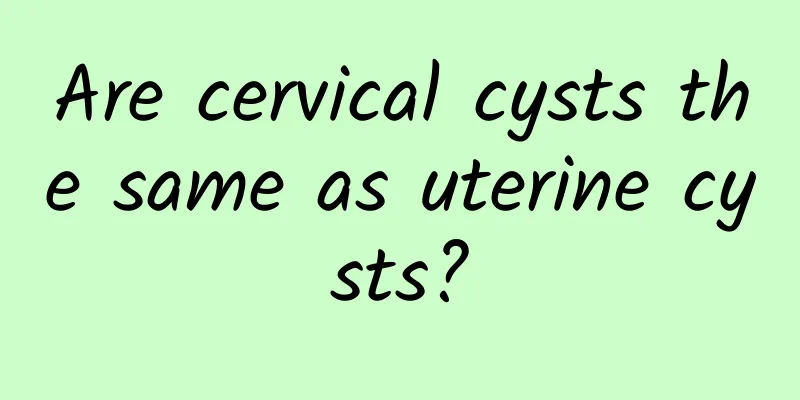Are cervical cysts the same as uterine cysts?

|
Cervical cysts and uterine cysts are not exactly the same. They are two different common gynecological diseases with different lesion locations, causes and symptoms. It is very important to distinguish them and treat them symptomatically. If you find related symptoms, it is recommended to seek medical attention in time to clarify the condition and avoid delaying treatment. 1. Cervical cysts: causes and treatment Cervical cysts are small cystic lesions formed by blockage of cervical gland secretions. They are common in patients with chronic cervicitis and are a relatively common pathological type. -Cause: Chronic inflammation often causes glandular hyperplasia, and the secretions cannot be discharged smoothly. They accumulate and form cysts. This is usually related to repeated infections, changes in hormone levels or anatomical structure. -Treatment: If there are no obvious symptoms or the infection is small, regular observation can be chosen; for patients with large infection or repeated infection, the following treatment methods are usually adopted: 1. Physical therapy: such as freezing or laser, to remove diseased glandular tissue. 2. Drug treatment: Antibiotics can be used to control infection and, if necessary, combined with local medications to improve inflammation. 3. Surgical treatment: If the cyst is large and the symptoms are obvious, it can be removed surgically to prevent further development. 2. Uterine cysts: causes and treatment Uterine cysts usually refer to cystic lesions that occur in the uterine wall or inside the uterus. They may be caused by a variety of causes, so further diagnosis is often required. -Causes: The most common ones include adenomyosis, functional cysts or cystic changes of uterine fibroids, which may be related to endocrine disorders, endometriosis and other factors. - Treatment: Different treatment methods are selected according to the cause and characteristics of the cyst: 1. Drug treatment: Suitable for functional cysts or mild endocrine disorders, hormone drugs are often used to regulate hormone levels. 2. Minimally invasive surgery: If the cyst is large in diameter or continues to grow, laparoscopic cyst removal can be an option. 3. Auxiliary treatment: Take Chinese patent medicine to regulate qi and blood circulation, and cooperate with daily observation to alleviate the progression of the disease. 3. How to distinguish between cervical cysts and uterine cysts Cervical cysts are mostly located on the surface of the cervix, occasionally accompanied by mild symptoms such as increased secretions and abnormal vaginal discharge, while uterine cysts are often found inside the uterus, and patients may experience abnormal menstruation, abdominal distension, or even infertility. Ultrasound, magnetic resonance imaging (MRI) and other imaging tests can identify the location and nature of the cyst, allowing for targeted treatment options. As mentioned above, although both cervical cysts and uterine cysts are cystic lesions, their locations, causes and treatments are significantly different. Women who find lesions should not ignore the condition and should go to a regular medical institution for a clear diagnosis and receive appropriate treatment to control the progression of the disease and protect their physical and mental health. |
<<: What are the symptoms of uterine fibroids?
>>: Is there a high chance of spontaneous abortion in cervical pregnancy?
Recommend
My metabolism is too bad. I gain weight by drinking water and my face looks pale! Chinese medicine doctor: Drink this tea to lose weight and improve your complexion
Many people have small stomachs and do not eat mu...
What are the effects of uterine fibroids on the left side of the wall? Does uterine fibroids on the left side of the wall affect pregnancy?
What are the effects of uterine fibroids on the l...
How long does it take to cure chronic pelvic peritonitis?
What is the treatment for pelvic peritonitis? Thi...
5 minutes a day to easily get a vest line (medium)
Vest line and mermaid line have always been the u...
What are the methods of abortion? There are 3 methods
With the development of today's society, abor...
What are the symptoms and causes of uterine fibroids?
Symptoms of uterine fibroids 1. Abdominal pain, b...
What are the prevention methods for vaginitis?
The occurrence of vaginitis has brought unspeakab...
How to treat third-degree cervical erosion? Detailed treatment of third-degree cervical erosion
I believe everyone knows the importance of the ce...
Gastric reduction surgery is not a panacea, you need to develop the habit of chewing slowly! Doctors teach 4 tips for chewing slowly
How long does it take you to eat a meal? Should y...
Is it normal for the endometrium to be 0.8 after the menstrual period?
Is it normal for the endometrium to be 0.8 after ...
What is the cause of infertility in patients with cervical erosion?
What is the cause of infertility in patients with...
What are the dangers of adenomyosis?
Adenomyosis, also known as intrauterine endometri...
Analysis of the causes of vaginitis in young girls and adolescent girls
MicrosoftInternetExplorer402DocumentNotSpecified7....
What are the symptoms of female cervical erosion? How to treat female cervical erosion?
Cervical erosion is a type of female disease. Tod...
What is a giant uterine leiomyoma? Definition of a giant uterine leiomyoma
What is a giant uterine leiomyoma? Definition of ...









